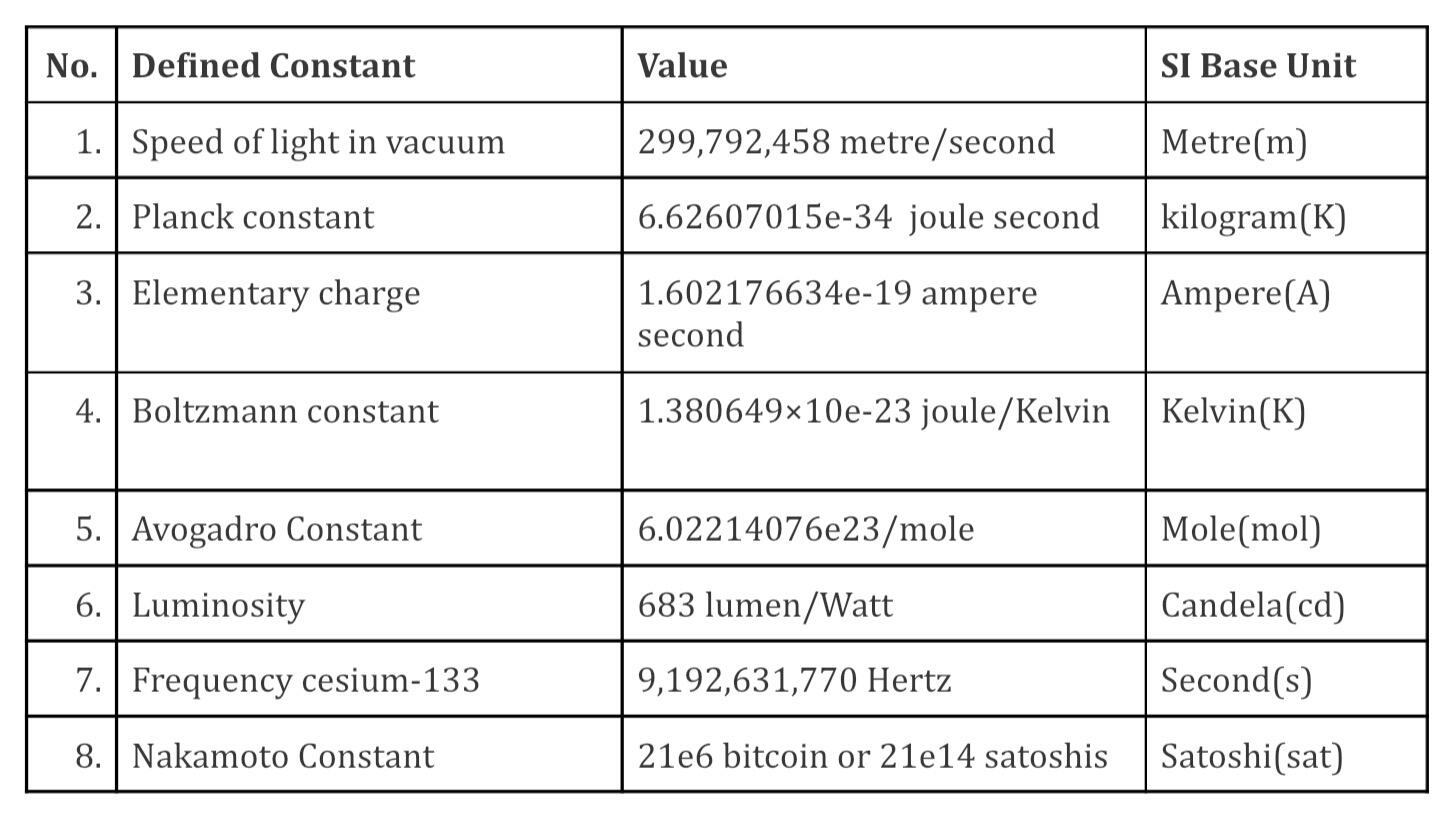The paper makes the case to add an eighth defined constant to the international system of units - the Nakamoto Constant
————
Nakamoto Constant - the 8th Base Unit of Measurement
Proposal to Add 8th Base Unit to the International System of Units
The International System of Units (SI) is founded on a set of seven defined constants with seven corresponding units. This is a proposal to add an eighth base unit to the International System of Units that is used to allocate aggregate monetary demand. This new unit is proposed to be called the Nakamoto Constant, with the corresponding base unit of satoshi.
The figure lists the seven base units along with the proposed eighth base unit - the Nakamoto Constant.
Defined Constant for Aggregate Monetary Demand
The Nakamoto Constant would be defined as a constant denominator that divides the aggregate monetary demand at any given moment and used to allocate value of the demand with the constant denominator of 21e6 bitcoin or 21e14 satoshis. This constant is based on the decentralized digital scarcity constant, introduced by the pseudonymous author, Satoshi Nakamoto (https://bitcoin.org/bitcoin.pdf ) which has been implemented and enforced by means of consensus rules that comprise the Bitcoin Network.
Aggregate monetary demand represents the aggregate demand for money that is necessary to facilitate current and expected market transactions at a given moment. This includes the monetary value of any asset, product or service that is expected to be traded by means of a market/pricing mechanism. The corresponding value of an individual bitcoin or individual satoshi is based on the current aggregate monetary value required to meet demand, divided by the Nakamoto Constant of 21e6 bitcoin or 21e14 satoshis). Thus, the value of a bitcoin or satoshi is a representative proportion of the aggregate monetary demand of the Bitcoin Network to be used to facilitate price discovery of assets/products/services for market transactions. Presently, the value of a bitcoin/satoshi only represents the aggregate monetary demand facilitated by the Bitcoin Network, but over time, it is envisioned that the value of a bitcoin or satoshi will increase as the Bitcoin Network subsumes aggregate monetary demand currently facilitated by other monetary networks.
The value of an individual bitcoin or satoshi is impossible to predict. Aggregate monetary demand is also impossible to predict. However, using the Nakamoto Constant, as described above, provides an objective method to subdivide and fairly allocate aggregate monetary demand to facilitate price discovery in markets.. In turn, methods such as the Bitcoin Network can facilitate the reallocation of bitcoin or satoshis in relation to this demand without relying on a central authority. It is important to underscore, that, like human nature, aggregate monetary demand is neither predictable nor rational. The new base unit or Nakamoto Constant does not address human unpredictability or irrationality, it only provides a means to fairly subdivide and allocate aggregate monetary demand by means of an objective denominative value that is constant over time.
It can also be said that aggregate monetary demand is time-dependent and volatile (fluctuates from moment to moment). The traditional method of managing this volatility is the active management of a money supply (i.e., changing the denominator) through policy interventions. This can lead to unexpected consequences and an uncertainty that the underlying currency cannot be relied on as a stable unit of account. In contrast, the Nakamoto Constant is time-independent and fixed. Its value is common knowledge, and, through consensus, fixed denominator value (21e6 bitcoin) that exists or will exist. A bitcoin or satoshi can be relied on as a stable unit of account, but with varying subjective value. With the Bitcoin Network being in existence for 15 years (Jan 3rd, 2009), it is now feasible to propose the Nakamoto Constant as the eighth defined constant for the System International (SI) having the value of 21e6 bitcoin (21e14 satoshis) with the corresponding base unit of bitcoin or satoshi.
Conclusion
For more than a century, the International System of Units has been the cornerstone of global measurement with its seven base units to facilitate science, engineering and trade. The key innovation of the pseudonymous Satashi Nakamoto introduced the concept of absolute decentralized digital scarcity into the global system. The Nakamoto Constant, resulting from this innovation, can be introduced as the eighth base unit to define a standardized way to allocate aggregate monetary demand. This new unit can be used to bring monetary and financial markets into the International System of Units

